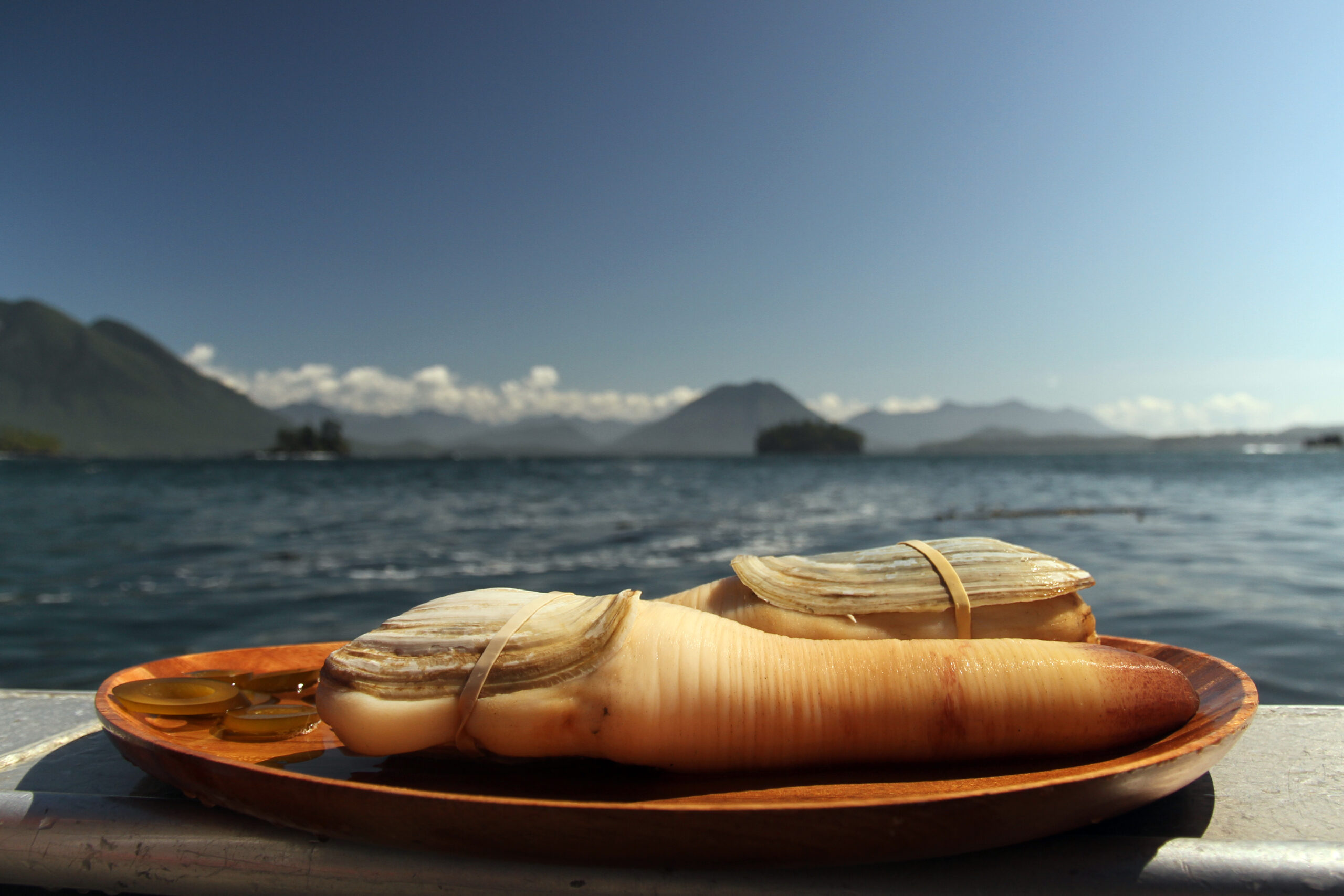In some ways, the plight of the wild BC geoduck reminds me of spot prawns—an unsung local treasure, formerly used as a chowder filler until the overseas markets caught wind of it, elevated it to the realm of luxury and made it difficult to obtain here at home.
(Before 2006, 97 per cent of BC Spot Prawns were exported to Japan–until some key chefs and fishermen launched the Spot Prawn Festival. Now, they’re everywhere during their short spring season!)
Similar to spot prawns, they don’t have a long shelf life and can only be held live in tanks for a few days, max.
Geoduck is difficult to source, even for restaurants (as spot prawns were way back when). Most of the fishery’s quota is pre-sold to overseas distributors and never even gets to market.
There are differences, of course. Geoducks aren’t quite as cute as those plump spot prawns with their dotted bellies.
That said, some would argue that the geoduck’s phallic resemblance is part of its weird charm. (Washington’s Evergreen State College turned the geoduck into a cuddly mascot!)
Some (mostly straight, male chefs, I’ve noticed) say geoduck is hard to handle because of the wrinkled sheath around the neck, which needs to be removed—like a snake shedding its skin, or a condom being unrolled.
The meat becomes chewy and unpalatable if overcooked, which can happen very quickly. (Spot prawns also overcook in a flash and need to processed carefully; if the heads aren’t removed right away, an enzyme turns the flesh black, soft and mushy.)
Most prohibitively, geoduck are expensive. Chinese restaurants generally sell the whole clam, which weigh one to three pounds (on average); the premium grades retail for about $90 a pound.
Fanny Bay Oysters does offer farmed geoducks, which are smaller, less expensive and more readily available. You can even buy the frozen meat online . But this product is farmed in Washington so it’s not quite a local BC hero. (Although some say the quality is more consistent and the taste is cleaner.)
Still, I can’t help thinking of wild BC geoduck’s potential. Lucky for geoduck (and those of us who appreciate it), it has a few champions.
Rob Clark, Aramé Now working as a culinary consultant, the founding chef of Ocean Wise–and BC’s biggest spot prawn champion –is also a TV star these days. He and Your Nation’s Table co-host Carmen Ruiz y Laza filmed an excellent episode all about geoduck . If you want a deep dive into this local fishery, it’s worth a watch.
Bobby Milheron, Tableau The executive chef for Wentworth Hospitality Group (Tableau, Homer St. Café, Maxine’s) likes geoduck so much he married into the royal family. (His wife, Katie Lindsay, is the marketing manager for the Geoduck Underwater Harvesters Association; his father-in-law, James Austin, is the association’s long-time chairperson.)
Milheron’s mission is to make this local delicacy more appreciated here at home. And after years of experimentation, he totally rocked (and won!) the regional Great Canadian Kitchen Party competition in 2023 with a unique rendition of geoduck that had been cured, lightly smoked, poached and lightly seared. The preparation transformed the texture (making it soft, almost like a scallop). Complemented with spot prawn terrine, pickled bull kelp, a geoduck/spot prawn reduction and a grated sunchoke cake, it was an absolutely brilliant dish.
**Stay tuned if you’d like to taste Milheron’s winning dish. We’re cooking up a private geoduck tasting-menu dinner. I’ll have more details in the next issue.**
Vancouver’s most decorated chef also rocked the regional Great Canadian Kitchen Party with a geoduck dish, in 2018, and went on to win the national Canadian Culinary Championship. His Parfait of Wild BC Shellfish was set in a rich custardy chowder, topped with a translucent layer of golden gelee—made from geoduck and sturgeon bones.
“I made stock with geoduck. That was sacrilegious to all the Asian chefs!” Chen told me recently. “But that’s why we won, because we had this tremendous stock with a super-concentrated flavour. There is no msg, no base powder, no Knorr cube that can ever replace the natural sweetness and deep umami-ness of geoduck.”
That super geoduck stock is Chen’s secret ingredient for his sumptuous vongole linguine at Wild Blue restaurant in Whistler.
Wild Blue Restaurant Vongole Pasta with Geoduck. David Buzzard Photography
“When you reduce manila clams for a vongole, the taste gets too salty,” he explained. “The best thing about geoduck is that it’s naturally sweet, like a scallop. The more you reduce it, the more focussed it becomes, without becoming salty. That’s the beauty of this dish.”
And that beauty of a dish has become the restaurant’s best-seller. Go Team Geoduck!
Geoduck ice cream? Savoury dessert and geoduck lovers alike will want to flock to this modern Asian-fusion restaurant in Richmond, which wins–hands down–for the most innovative use of geoduck. During the month of March, Little Karp will be featuring a three-course geoduck dinner ($188 for two people) that features: a beautiful sharing board with geoduck multiple ways (sashimi, ceviche, beer-battered and in pork soup); a main course with geoduck in squid-ink risotto as an option; and dessert.
The ice cream, which I previewed this weekend, is churned in-house with geoduck stock, salted egg yolk and cream. It definitely has a fishy bite, enhanced by smoked salmon floss. But when mixed with whipped cream served on the side, the sweetness pops. It’s a quirky chameleon of a dessert. And the tasting menu is a terrific way to try geoduck in various guises.
Little Karp is able to keep the menu price relatively low, by the way, because the owners also own Aqua King Seafood, a wholesale distributor that supplies geoduck to restaurants. Premium quality and freshness guaranteed!


